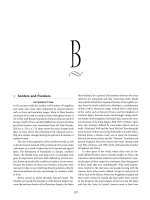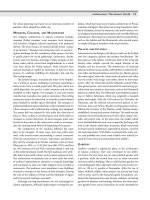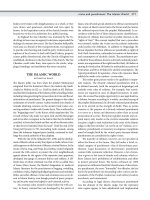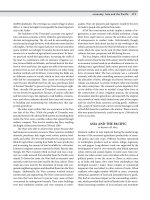Encyclopedia of society and culture in the medieval world (4 volume set) ( facts on file library of world history ) ( PDFDrive ) 209
Bạn đang xem bản rút gọn của tài liệu. Xem và tải ngay bản đầy đủ của tài liệu tại đây (47.03 KB, 1 trang )
182 cities: Africa
Portuguese caravels began sailing down the West African
coast, disrupting trading ports and carrying out a murderous
trade in slaves and gold. As Europeans established depots and
trading stations in West and East Africa, Christian missionaries followed them. The effort to settle and exploit Africa’s human and natural resources brought about new concepts of city
design and function in sub-Saharan Africa.
Fall
of
Rome
and
Alexandria
The city of Alexandria, founded by the Macedonian general
Alexander the Great in the fourth century b.c.e., remained
the busiest port in the Mediterranean for several centuries.
A vital link in the importation of grain from the Nile River
valley to Rome, Alexandria was a major harbor and a city
of fine palaces, mansions, and public buildings laid out on
a regular grid of streets divided into four major quarters. As
a cultural center Alexandria was unsurpassed in the Mediterranean world; it was home to respected philosophers and
astronomers, and its library and academies were renowned
throughout the empire.
The decline of the Western Roman Empire in the fifth
century wrought a transformation in the city. As its harbor
declined in importance, Alexandria lost population and grew
isolated from the Nile Valley as well as the new center of imperial authority, the eastern capital of Constantinople (modern-day Istanbul), far to the north on the bridge between Asia
Minor and Europe. Pagan temples and monuments in Alexandria were thrown down by the dominant Christians, and
the city’s libraries and academies were largely abandoned.
In 616 Alexandria was overrun by a Persian army under
King Khosrau II. An Arab army arrived to lay siege in 641; the
citizens endured 14 months of assaults before the city finally
surrendered in 642, having lost its renowned library and the
thousands of manuscripts contained within it. The Arab conquest of Egypt and North Africa that soon followed destroyed
the last remnants of Roman culture on the continent and
began an era of Islamic domination of North African cities,
trade, religion, and culture that has lasted to the present.
Axum
In the early Middle Ages, while Alexandria declined into a
small and isolated coastal settlement, the Axum Empire of
northern Ethiopia was prospering. The abundant rainfall in
the region allowed its farmers to produce two harvests every year. Terracing of the mountainsides increased the area
under cultivation. The bumper crops and the wealth that
flowed along trading routes between mountainous Ethiopia
and the Red Sea created a prosperous merchant class whose
members spent their disposable income on luxury items created by artisans in wood, stone, gold, and gems. By the fifth
century c.e. the capital of Axum was one of the wealthiest
cities in Africa.
Axum drew a large population of migrants and foreigners while extending its power to far-flung valleys and towns in
the Ethiopian highlands. Trade through the Red Sea port of
Adulis linked the city to India, Persia, and the Mediterranean
ports of the Byzantine (Eastern Roman) Empire. The city imported cattle, iron, and salt while exporting luxury goods
from the interior of Africa, including ivory, rhinoceros horn,
gold, spices, frankincense, and war elephants. Metalworking
technology arrived from the Middle East via the Nile Valley,
giving rise to a busy iron industry; Axum was one of the first
realms in sub-Saharan Africa to mint its own coins. Beginning in the fourth century the Axumites adopted Christianity through links to the eastern Mediterranean. (Christianity
remains an important faith in modern Ethiopia.)
The Axumite nobles built impressive mansions in the
city and provided a market for expensive cloth, wine, glass,
and spices from Arabia and the Levant. The Axumite kings
celebrated their lives and their reigns by raising tall obelisks,
more than 100 of which eventually fell and now litter the
streets and parks of the modern town of Axum. The tallest of
these monuments was 108 feet high. The most elaborate obelisks had detailed bas-reliefs carved into their surfaces.
Axum began a slow decline soon after the fall of the Roman Empire, which had traded with Axum via Egypt and the
lower Nile Valley. Axum’s foreign markets either vanished
or were besieged and conquered by Islamic armies sweeping
across the eastern Mediterranean and down the coast of the
Red Sea. The city’s farming hinterland also suffered environmental damage. As trees were cut down to provide wood for
the furnaces of metal foundries and for the manufacturing
of brick and glass, the soil began to erode, and crop yields
suffered. The situation worsened as rainfall began to decline
in the eighth century; the port of Adulis was conquered by
the Arabs in the same period, and Axum’s main link to the
outside world, and its main source of revenue, disappeared.
Urban society grew tumultuous, with violent revolts brewing
in the streets and hunger rampant. The city’s nobility took
refuge in isolated hilltop fortifications and then moved to
central Ethiopia, leaving Axum a poor and sparsely inhabited ghost town.
The Axum Dynasty was finally toppled and Aksum itself destroyed in the 10th century, after an assault by Queen
Guldit, a determined opponent of Christianity. In 1137 the
Zagwe rulers ascended to power from their capital at Roha
in the Lasta Mountains. In this northern town (modern-day
Lalibela), a series of 12 rock-cut churches were constructed
during the reign of King Gebre Mesqel Lalibela, which ended
in the early 13th century. This Christian king envisioned Roha









